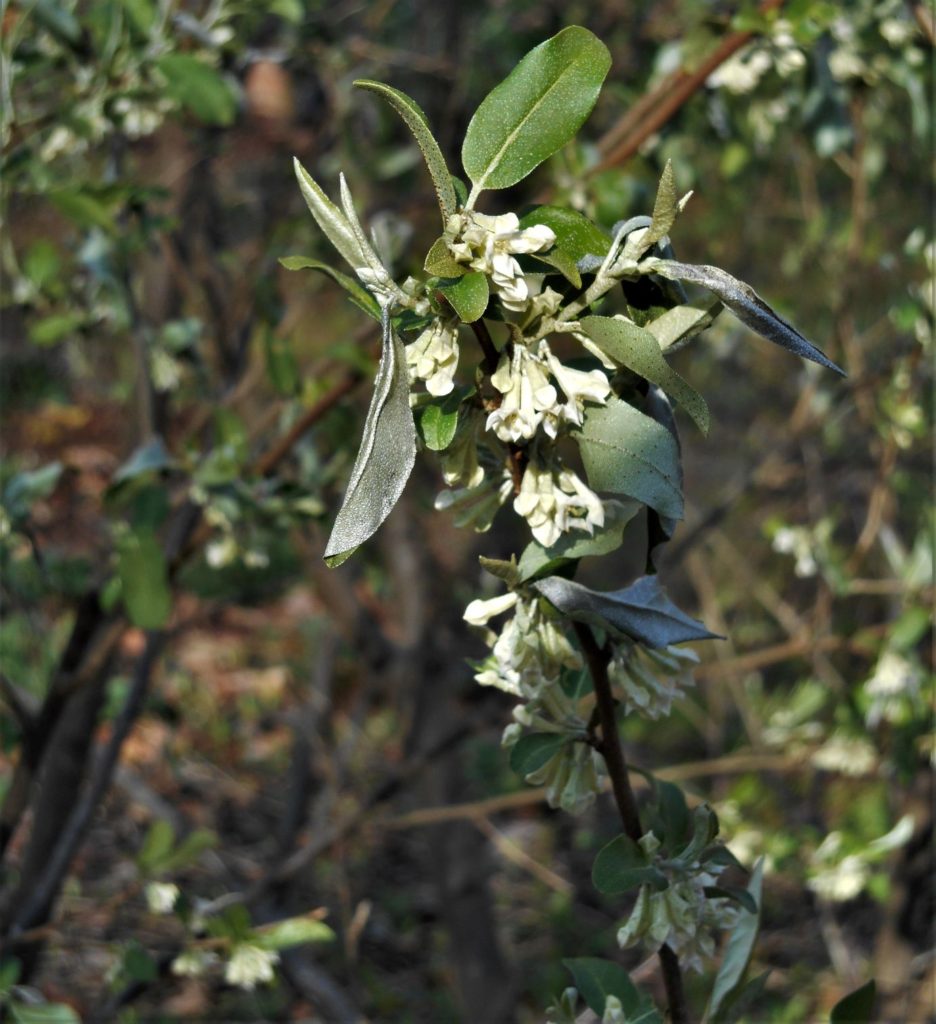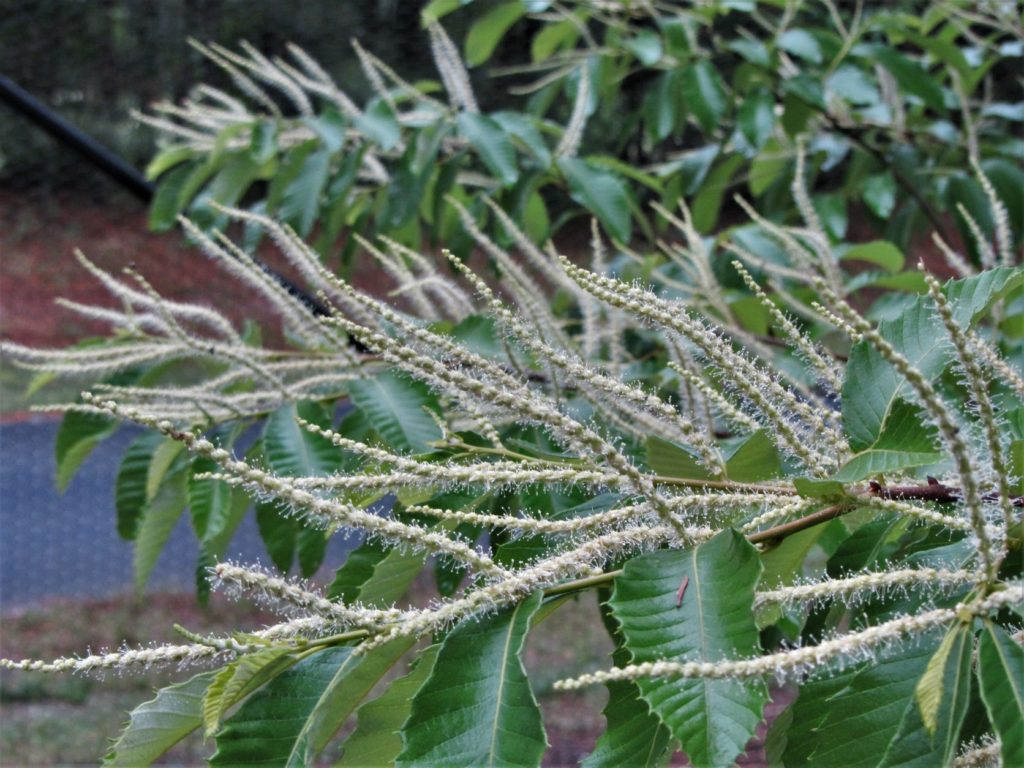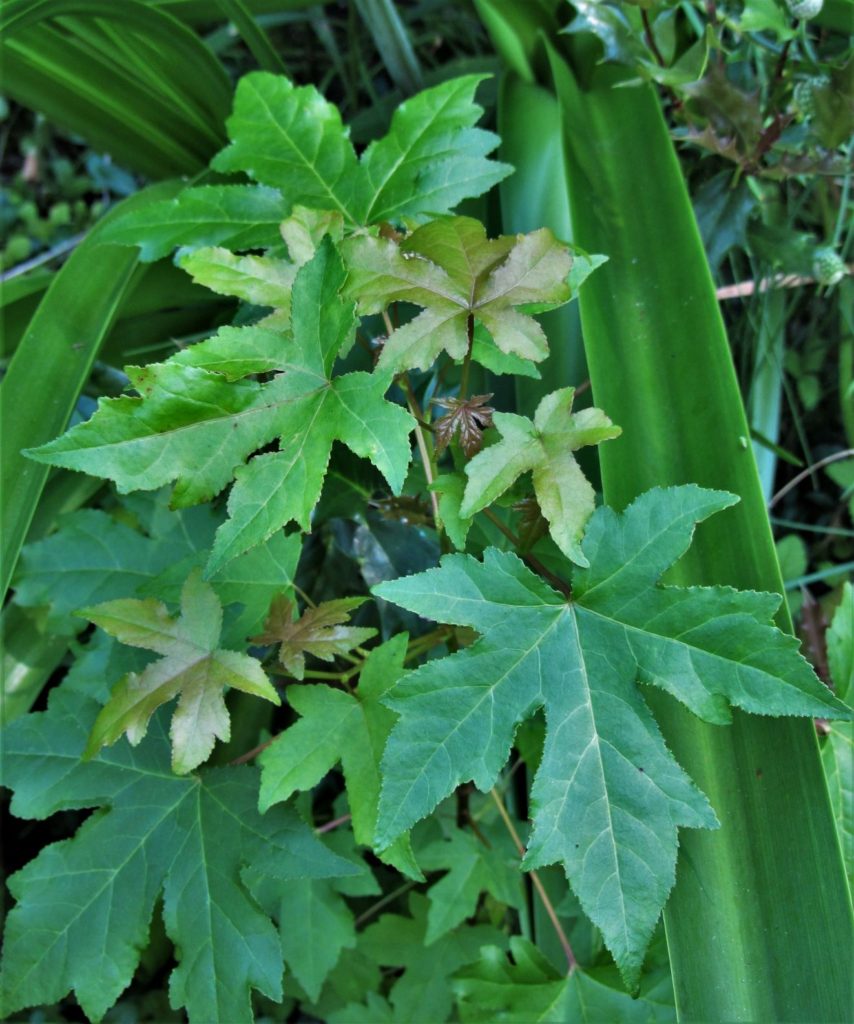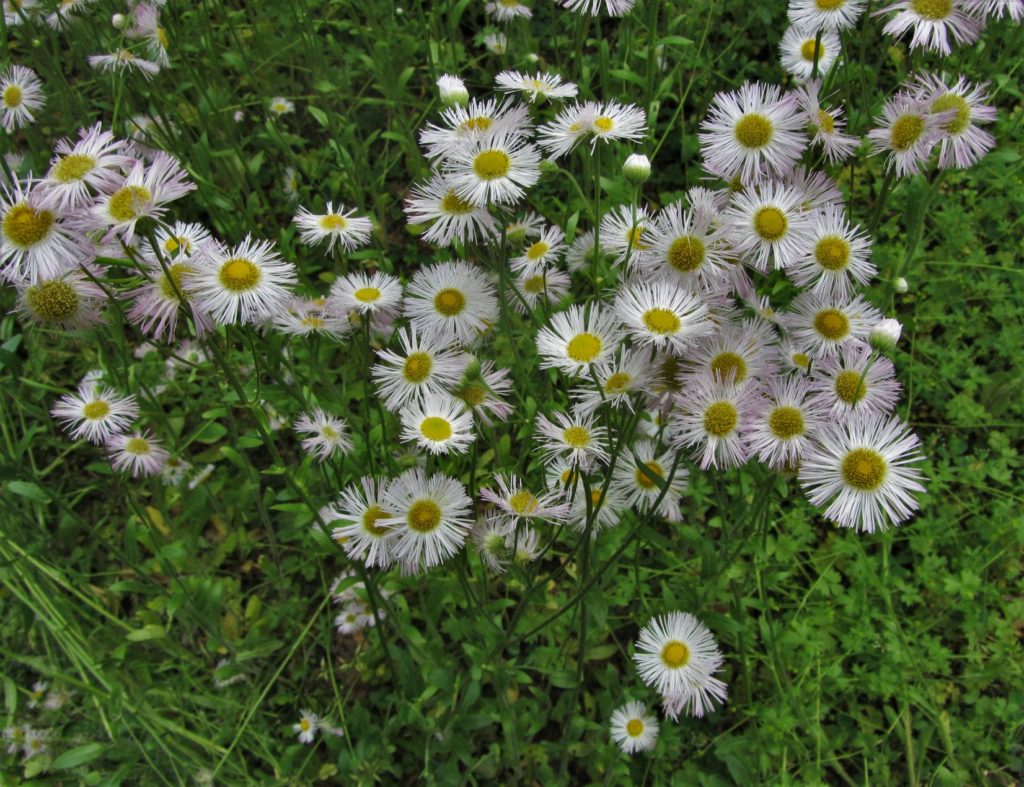Noxious or Nice?

Autumn olive blooms in early spring, then produces fruit in autumn. As birds spread the seed, it has become highly invasive.
The swiftest way to find yourself in a rollicking argument with someone you may otherwise count as a friend, is to disagree with them over whether a plant is useful in the garden, or is a noxious, invasive weed. This drama can erupt among those of us passionate about our gardens and the plants we grow. We all know just enough to know we’re right, but these arguments over plants can hinge on nuance and circumstance.
Do you know a weed when you see one? A weed is any plant growing in a place where you don’t want it to grow. Gardens, by definition, are spaces people cultivate for their own purposes. And we populate our gardens with plants that mean something to us.

Flowers or weeds? Two of these plants are Virginia native host plants. All support pollinators and serve as effective ground covers. One produces fruit for birds and other small animals.
While I cultivate an acre planted in a forest, you may have two porches and the small patio that came with your condominium. Or, your home may have a clear-cut suburban yard planted on fill left by the contractor. Our friend may garden on a small farm in the country, or may garden in a wetland along a creek. While our circumstances and our needs differ, we each have an opportunity to grow many different sorts of plants in these garden spaces.
The golden rule of gardening remains, ‘Right plant, right place.’ I would expand that to, ‘Right plant, right purpose.’ What do we want from the plants we grow? Beauty? Food? Knowledge? Profit? Or are we most interested in supporting wildlife and protecting our environment? We choose plants to fill a variety of needs.

Hibiscus syriacus or tree Hibsicus, native in Asia, supports pollinators and birds for many month of the year. It reseeds freely. While you may pay top dollar for a special hybrid, I often pull and discard seedlings that germinate where I can’t let them mature.
Our American gardener ancestors sought out useful plants from across the globe. Read Andrea Wulf’s Founding Gardeners or The Brother Gardeners for a deeper understanding of the lengths our nation’s founders went to import plants for food and commerce, while profiting on North American native plants exported to European gardeners. There is a long history of botanists and horticulturalists traveling around the world in search of new, beautiful, and useful species of plants. Thomas Jefferson wrote that, “The greatest service which can be rendered any country is to add a useful plant to its culture….”
American colonists and immigrants brought many new and useful plants with them to use in their new American lives: dandelions, daffodils, citrus, ivy, tulips, salad greens, grapes, watermelon, okra, roses, barley, yams, apples, herbs, hops and many more. Weeds, like crabgrass and stilt grass, came along too. Soon the native ecosystems of the Americas were forever altered by European and African immigrants. Trade in plants continued along with global exploration, and plants collected in Asia, Africa, Australia and the Pacific Islands, and so many other places, found their way to Europe and its North American colonies.

Native Castanea pumila, or Allegheny chinquapin, is a type of chestnut tree that supports pollinators and produces delicious nuts. It is one of the many native trees colonists exported to botanists in Europe. Allegheny chinqapin grows at the Williamsburg Botanical Garden and Freedom Park Arboretum.
It takes a little sleuthing to learn where familiar plants originated. We may or may not care. We all garden in novel landscapes, now, with our native ecosystems of trees, herbaceous plants, insects and animals badly compromised. Many imported plants, like dandelions, quickly spread by seed and rhizome, crowding out the original native flora.
Which is exactly why many of us have turned to native plants to rebuild these webs of life crucial to support the many insects, including butterflies and bees; birds; and other animals, indigenous to our area. We depend upon our native bees and other pollinators for crop and seed production. Many remain very particular about which plants their larvae require to mature, and which plants their adults will visit for sustenance. Once we lose our native insects, the rest of the food web, upon which we depend, will collapse. It is a fine balance, which we have already disrupted in critical ways.

Liquidambar styraciflua, or American sweet gum, grows into a large tree. It produces hard ‘gumballs’ to hold its seeds, and may not be desirable in many yards.
Ecologists tell us that planting native plants in our gardens can help reverse this ecological damage, by supporting native insects and birds. Native trees, like oaks, black cherry and maples support the greatest number of insect species. But they also warn us that planting imported species that shade or crowd out natives, and that don’t support birds and insects, accelerates the harm.
Which brings us full circle to our arguments over whether a plant is noxious and invasive or is a rather nice and useful plant for our garden. Sometimes it comes down to persistence and promiscuity. Once planted, how long will a plant remain in your garden? And how quickly will it multiply?
Some plants tend to be promiscuous, spreading themselves around by seed production and by stem, root and rhizome reach. One plant multiplies quickly into dozens. Vines grow by several inches each month, sending out new roots at each leaf node. Some plants grow larger and spread themselves around beyond what we may intend.

Native goldenrod seeds blew into my yard and took root. They have promiscuously multiplied, crowding out plants I would prefer to grow. These are native Solidago species that are highly desirable for wildlife because they bloom in late autumn. It takes a lot of time and energy to thin them each spring.
Many native plants out compete their neighbors and spread aggressively, too. If you have had goldenrod, Solidago species, colonize in your yard you know what I mean. But we don’t call our native species ‘invasive,’ no matter how exuberantly they may grow.
A gardener trying to plant a large space may value a beautiful plant that multiplies quickly, awarding extra points if it supports pollinators and is also resistant to deer and vole nibbling. Lenten roses come to mind, along with Iris, periwinkle and daffodils. Most of us would agree that these are desirable plants and willingly buy them each year. Other gardeners will note that these are European natives, will persist beyond the lifetime of the gardener, and may crowd out site native plants.

European Narcissus triandrus ‘Thalia’ persistently return in greater numbers each year. Native Rudbeckia hirta have seeded into this bed, crowding out the Iris and lamb’s ears I originally planted.
You would never know that many species are considered nuisance plants, or invasive, from a trip to a garden center. Most are perfectly legal to sell. It is up to us, as informed gardeners, and responsible consumers, to do our homework and avoid buying, planting, and perhaps even avoid nurturing certain plants. This is difficult when it concerns a plant you happen to like growing. I have a weakness for beautiful ivy, especially when it’s grown in pots.
It may take a few decades for a new plant introduction to cause enough problems in its novel environment to find itself reclassified as an invasive, nuisance plant. The very qualities that make an introduction exciting and marketable may also make it harmful to its new ecosystem.
Back in the 1980s, online nurseries advertised autumn olive, Elaeagnus umbellate, as tough, wildlife friendly shrubs for hedges, windbreaks and foundation plantings. Early spring flowers attract pollinators and their autumn fruits feed a variety of birds. Autumn olive was marketed hard, sold very cheaply, and was planted widely. They are tough and persistent; too persistent. Cut them back hard, and new shoots soon grow.
It didn’t take long for birds feasting on autumn olives to spread their seeds far and wide. Young shrubs quickly shade out other plants around them, claiming more and more real estate as native species nearby are outcompeted. Now you’ll find Elaeagnus umbellate, on the Virginia Department of Conservation and Recreation’s list of highly invasive species, along with Elaeagnus pungens, thorny olive, which has a slightly lower ranking for invasiveness.

Dense planting provides benefits over a long season. Each plant may not be equally desirable, but each has a role to play. Native Muscadine grape vines emerge among the daffodils, comfrey, Arum and chives.
To rate a spot on the list of highly invasive species, there must be demonstrable evidence that a species poses a threat to Virginia’s forests, native grasslands, wetlands or waterways. Autumn olive is now considered invasive across all geographical regions of Virginia, and many other states.
Another whole group of plants hasn’t yet made it to an official invasive species list, but they cause significant problems in some areas. Nandina domestica drupes are highly poisonous to wild birds and mammals. It suckers and spreads with abandon. Yet most nurseries continue to sell it. Other plants, like Arum italicum or Zantedeschia aethiopica may be invasive in some riparian environments, but useful and beautiful in others.
The Lewis Ginter Botanical Garden published its Dirty Dozen list of invasive and nuisance plants prevalent in central Virginia in 2020. Most of us living in older, established landscapes have at least one plant on this list growing in our yards.

Many older homes have Nandina domestica, or heavenly bamboo, growing in their yard. It is valued for its evergreen leaves and red drupes through the winter, and it supports pollinators in the spring. This is one of the ‘Dirty Dozen’ nuisance plants and its berries are highly toxic.
It’s hard to avoid using invasive and ‘nuisance’ plants. You will find invasive plants for sale in local nurseries and in many plant catalogs. If you don’t happen to know the plant is invasive, you’ll happily buy it, plant it, and then it may be years later before you realize the mistake.
It is up to us, as informed gardeners, and responsible consumers, to do our homework and avoid buying, planting, and perhaps even avoid nurturing invasive plants. We can prune away the flowers from some plants before seeds set. We may need to closely control, or eradicate, others.
Mostly we need to reach clarity about why we grow what we do. Plants aren’t necessarily ‘good’ or ‘bad,’ and we can agree to disagree about whether they are useful. All plants can add beauty and value to our lives while they filter the air, provide food and cover for wildlife, and hold the soil against erosion. I like our county Environmental Protection office’s general advice to ‘Plant More Plants.’
Let’s share our love of plants with our communities and plant gardens wherever we live. But let’s do it mindfully, with respect for the web of life, and with awareness of our how choices and stewardship impact the local environment, where we also live and grow.

Native fleabane, Erigeron, may be a wildflower or a weed in the lawn. it depends on your point of view.
For More Information:
Virginia’s Invasive Plant List.
State Arboretum of Virginia Alien Invasive Landscape Plants in Virginia
Lewis Ginter Botanical Garden’s ‘Dirty Dozen’ Invasive plant list
https://www.monticello.org/site/research-and-collections/tje
Blom, Jenny. The Thoughtful Gardener: An Intelligent Approach to Garden Design. 2017.
Mellichamp, Larry. Native Plants of the Southeast: A Comprehensive Guide to the Best 460 Species for the Garden. 2014.
Oudolf, Piet and Henk Gerritsen. Planting the Natural Garden. 2019.
Tallamy, Douglas. Nature’s Best Hope: A New Approach to Conservation That Starts in Your Yard. 2020.
Vogt, Benjamin. A New Garden Ethic: Cultivating Defiant Compassion for an Uncertain Future. 2017.
Wulf, Andrea. The Brother Gardeners: A Generation of Gentlemen Naturalists and the Birth of an Obsession. 2010.
Wulf, Andrea. Founding Gardeners: How the Revolutionary Generation Created an American Eden. 2012.
All Photos by E. L. McCoy


